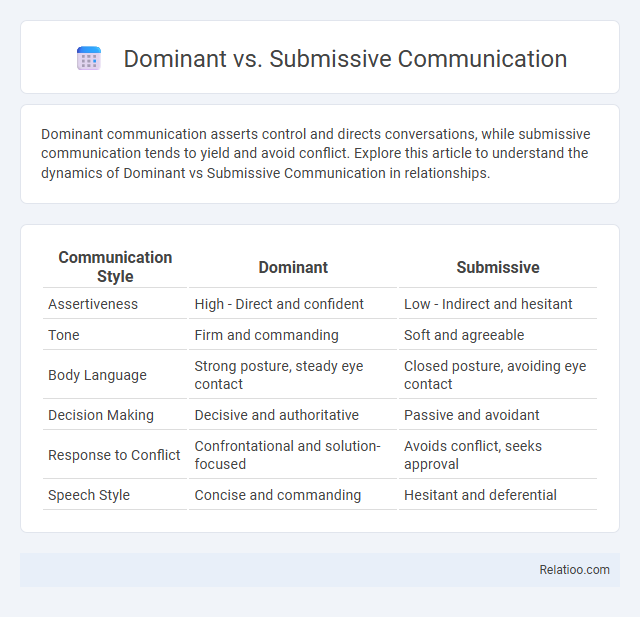Dominant communication asserts control and directs conversations, while submissive communication tends to yield and avoid conflict. Explore this article to understand the dynamics of Dominant vs Submissive Communication in relationships.
Table of Comparison
| Communication Style | Dominant | Submissive |
|---|---|---|
| Assertiveness | High - Direct and confident | Low - Indirect and hesitant |
| Tone | Firm and commanding | Soft and agreeable |
| Body Language | Strong posture, steady eye contact | Closed posture, avoiding eye contact |
| Decision Making | Decisive and authoritative | Passive and avoidant |
| Response to Conflict | Confrontational and solution-focused | Avoids conflict, seeks approval |
| Speech Style | Concise and commanding | Hesitant and deferential |
Understanding Dominant and Submissive Communication
Dominant communication often involves assertive language, directive statements, and a strong presence aimed at controlling the conversation, while submissive communication tends to use passive language, hesitations, and agreement to avoid conflict or assertiveness. Understanding these communication styles helps identify power dynamics in interactions, where dominant communicators lead discussions and submissive communicators typically yield or comply. Recognizing these patterns allows for better conflict resolution and more balanced relational exchanges without misinterpreting interruptions as mere rudeness.
Key Characteristics of Dominant Communication
Dominant communication is characterized by assertive language, confident tone, and direct eye contact, often aiming to control the conversation flow and influence others' decisions. Your speech may use commanding phrases, interruptions, and a louder volume to establish authority and demonstrate leadership. Unlike submissive communication, which is passive and agreeable, dominant communicators prioritize their ideas and needs over others.
Key Characteristics of Submissive Communication
Submissive communication is characterized by passive behavior, low voice volume, avoidance of eye contact, and frequent apologies, reflecting a reluctance to express personal opinions or assert needs. You might often downplay your achievements or defer to others to avoid conflict, exhibiting a tendency to agree even when disagreeing internally. This communication style contrasts sharply with dominant communication, which is assertive and controlling, and frequent interrupting, which can indicate dominance or impatience rather than submission.
Psychological Roots of Communication Styles
Dominant communication stems from psychological needs for control and assertiveness, often linked to high self-confidence and a desire for influence in social interactions. Submissive communication typically arises from anxiety, low self-esteem, or fear of conflict, reflecting a psychological pattern of yielding to others to maintain harmony. Interrupting behavior is rooted in dominance expression or conversational control, frequently influenced by underlying insecurities or a need to assert power in communication dynamics.
Benefits and Drawbacks of Dominant Communication
Dominant communication often asserts control and direction, which can lead to clear decision-making and efficient goal achievement, benefiting environments that require strong leadership. However, this style may also limit open dialogue, causing others to feel undervalued or dismissed, which can hinder collaboration and reduce overall team morale. Understanding your dominant communication style allows you to balance assertiveness with empathy, fostering better interpersonal relationships and more inclusive conversations.
Benefits and Drawbacks of Submissive Communication
Submissive communication allows you to maintain harmony and avoid conflict by expressing agreement and yielding in conversations, fostering smoother interpersonal interactions and reducing tension. However, this communication style may lead to misunderstandings, as your needs and opinions can be overlooked or undervalued, potentially causing frustration and decreased self-esteem. Balancing submissive behavior with assertiveness ensures your voice is heard without dominating or interrupting others.
Real-World Examples of Dominant vs Submissive Interactions
Dominant communication often manifests in workplace meetings where a manager directs conversations and dictates decisions, demonstrating control through assertive language and frequent interruptions. In contrast, submissive communication is seen in team members who hesitate to voice opinions or are consistently interrupted without pushing back, reflecting lower confidence or deference. Real-world examples include boardrooms where dominant executives monopolize dialogue while junior staff remain silent or submissive, impacting collaboration and decision-making dynamics.
Impact on Relationships and Workplaces
Dominant communication often asserts control and can create power imbalances, leading to resentment and reduced collaboration in relationships and workplaces. Submissive communication may cause individuals to suppress their ideas and needs, resulting in misunderstandings and decreased self-esteem. Interrupting disrupts dialogue flow, signals disrespect, and hinders effective problem-solving, negatively affecting trust and productivity.
Strategies to Balance Communication Styles
Balancing dominant and submissive communication styles requires recognizing power dynamics and fostering mutual respect through active listening and assertive expression. Strategies include setting clear boundaries, encouraging equal participation in conversations, and practicing reflective feedback to minimize interruptions and promote understanding. Integrating empathic communication techniques helps create a collaborative environment where all voices are valued and interruptions are constructively managed.
Cultivating Assertive Communication as an Alternative
Dominant communication often involves controlling the conversation and interrupting others, which can stifle open dialogue and create tension. Submissive communication, on the other hand, leads to your ideas being overlooked or ignored, diminishing your influence. Cultivating assertive communication allows you to express your thoughts confidently and respectfully, fostering mutual understanding without resorting to interrupting or yielding excessively.

Infographic: Dominant vs Submissive Communication
 relatioo.com
relatioo.com